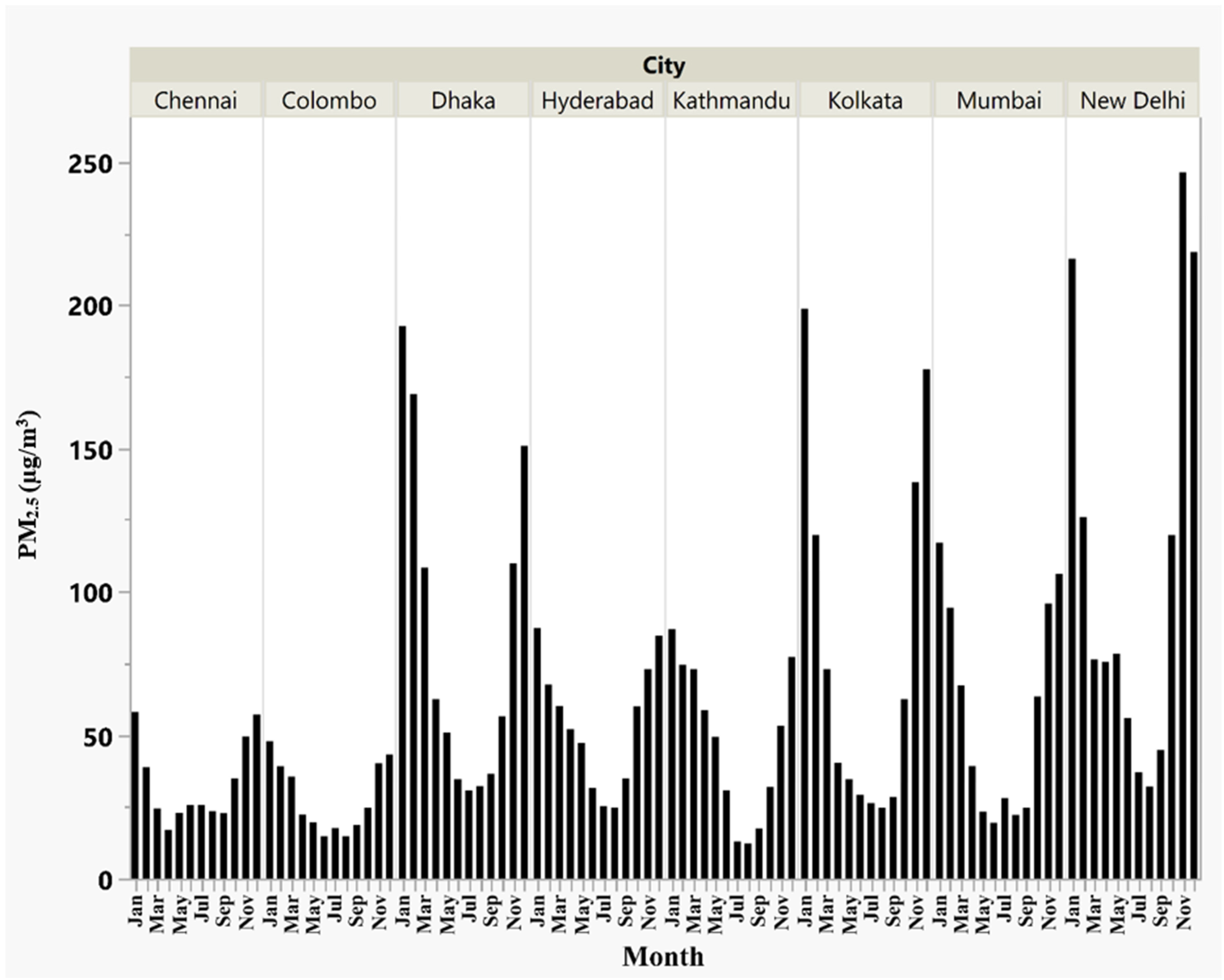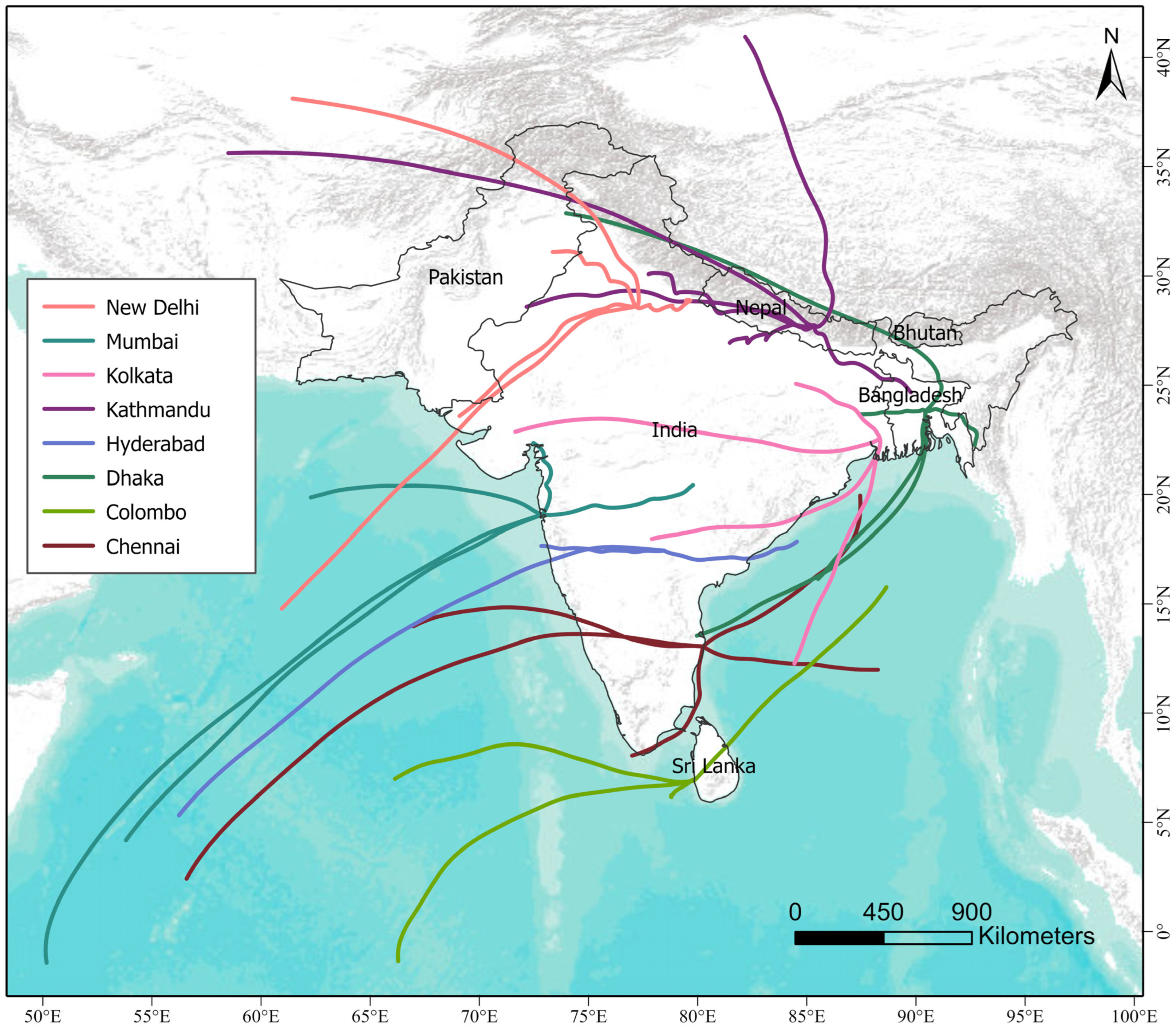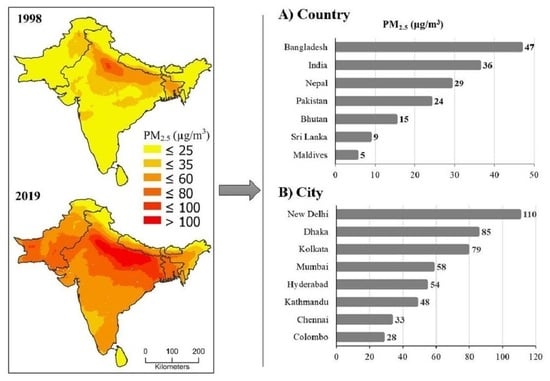1. Introduction
Air pollution poses a serious threat to the environment and global public health. Approximately 16% of worldwide annual mortality has been related to air pollutant exposure via inhalation of toxic air [
1]. Among various atmospheric pollutants, particulate matter (PM) has been receiving substantial attention worldwide because of its high potential to cause severe health problems, environmental (haze) pollution, and economic losses [
2,
3,
4]. More emphasis has been placed on particulate matter pollution because research has demonstrated more robust associations between elevated fine PM concentrations and negative health impacts [
5].
South Asia is one of the most densely populated regions, with 22% of the world’s population living on approximately 3% of the global landmass [
6]. According to the WHO (2016), 10 out of 20 of the world’s most polluted cities in terms of PM
2.5 are located in South Asia [
7]. All South Asian countries (Afghanistan, Bangladesh, Bhutan, India, Maldives, Nepal, Pakistan, and Sri Lanka) are currently experiencing rapid economic development and are involved in industrialization, urbanization, and other development activities that result in large amounts of air pollutant emissions, including PM
2.5 [
6,
8]. However, these countries lack adequate technologies and structure for implementing existing air pollution control policies or regulations, resulting in poor ambient air quality (AAQ) standards compared with the WHO-recommended AAQ standards. For instance, the mean PM
2.5 (µg/m
3) in Bangladesh, India, Pakistan, and Sri Lanka ranges between 15–40 (annual) and 35–65 µg/m
3 (24 h), which exceeds the WHO-recommended AAQ standards (i.e., 10 and 25 µg/m
3, respectively) [
9,
10,
11,
12].
Consequently, deaths attributed to ambient PM
2.5 exposure have increased in the South Asian region over the last few decades. A recent study by Krishna et al. (2017) found that the third-ranking risk factor for mortality in South Asia was exposure to ambient PM
2.5 in 2015 [
13]. They also found that Bangladesh, India, and Pakistan have a higher burden of PM
2.5 exposure due to larger populations and increased growth. David et al. (2019) reported 1.1 million annual premature deaths caused by PM
2.5 exposure in India [
14], whereas Shi et al. (2018) reported 163,000, 134,600, and 16,200 premature deaths annually in Bangladesh, Pakistan, and Nepal, respectively [
15]. A study by Xue et al. [
16] estimated the impact of ambient air pollution on pregnancy losses in South Asia. They revealed approximately 349,681 pregnancy losses are attributed to air pollution each year in Bangladesh, India, and Pakistan. Thus, PM
2.5 and associated risks are continuously receiving more attention from public health experts, governments, and international bodies worldwide in the effort to control ambient PM
2.5 emissions at local, regional, and global scales [
17]. In South Asia, collective regional action is needed to monitor and regulate air pollution. Countries have implemented particulate monitoring programs in recent years, but such initiatives have lacked the comprehensive regional coordination necessary to effect lasting change.
The South Asian population is among the most heavily exposed to PM
2.5 worldwide [
13]. In 2015, the Global Burden of Disease (GBD) study indicated that the population-weighted mean PM
2.5 concentration in South Asia was 73 μg/m
3, or 63.3% of the global average of 44 µg/m
3. This study also reported that population-weighted PM
2.5 concentrations increased by 24% in South Asia between 1990 and 2015. Increased exposure to particulate matter pollution can cut life expectancy by more than five years per person in South Asia. According to the latest Air Quality Life Index developed by the University of Chicago, the countries, including Bangladesh, India, Nepal, and Pakistan, account for more than half of the total life years lost globally to pollution. Bangladesh alone loses 6.8 years of life on average per person, compared to 3.6 months in the United States [
18]. It is evident that the sources of ambient air pollution vary across the region and rural and urban settings [
13,
19]. Therefore, developing an understanding of the spatiotemporal distribution of PM
2.5 at local and regional scales is necessary to model the pollution status and dynamics of specific sites, and in the design and implementation of site-specific policies to control PM
2.5 pollution.
Data derived from satellite and ground-station monitoring provide insights into PM
2.5 exposure, but the quality and availability of datasets vary regionally. Given the high expense of establishing and maintaining in situ measurement stations, satellite retrieval of PM
2.5 is a cost-efficient alternative for PM
2.5 monitoring at a large spatio-temporal scale. Despite substantial monitoring efforts over past decades, observational networks are not dense enough to examine the spatial distribution of air pollutants in South Asia [
20]. Satellite data provide a means to fill this gap. The integration of in situ and satellite observations of air pollution has significantly improved monitoring efforts, with in situ data providing important data validation.
This study aimed to explore the spatiotemporal variations of PM2.5 concentrations in South Asian countries using both in situ and satellite data. Per our review of current literature, few studies have been conducted to comprehensively assess the long-term and large-scale spatiotemporal variations in PM2.5 pollution in South Asia using both in situ and satellite measurements of PM2.5. Additionally, the origin and long-range transport of PM2.5 pollution and the number of deaths associated with ambient particulate matter in the South Asian countries were also investigated in this study. The specific objectives of this study were to (1) reveal the spatiotemporal characteristics of PM2.5 concentrations in South Asian countries between 1998–2019 using satellite data, (2) examine the spatiotemporal changes in PM2.5 concentrations in major South Asian cities between 2016–2019 using in situ measurements, and (3) assess the long-range transport of particulate mass to the South Asian cities. The results of this study will aid in understanding the characteristics of the long-term trends of PM2.5 in South Asia and their health effects on massive regional populations. It will also inform the design of effective strategies to mitigate air pollution and its health damage in this region and developing countries elsewhere.
2. Materials and Methods
This study assesses the dynamics of PM
2.5 pollution in South Asian countries using both in situ and satellite-based observations. The South Asian region is one of the most polluted regions in the world. The monsoon plays an important role in air quality in this region. According to a study by Lelieveld et al. [
21], the South Asian monsoon not only efficiently purifies the air of pollutants but also distributes them across the globe. The South Asian monsoon is a critical weather phenomenon for the region, as it brings most of the annual rainfall needed for agriculture and sustenance. It is a seasonal wind pattern characterized by a shift in the direction of prevailing winds. The monsoon in South Asia typically lasts from June to September [
22]. However, the monsoon can also lead to flooding and other weather-related challenges, making it both a blessing and a challenge for the people of South Asia. The Himalayan Mountain range plays a significant role in influencing the direction and intensity of the monsoon winds in this region.
2.1. Satellite Observed PM2.5 Data
High spatial resolution (0.01° × 0.01°) PM
2.5 concentration data from 1998–2019 were acquired from the Socioeconomic Data and Applications Center (SEADC) at Columbia University (available at
https://sedac.ciesin.columbia.edu/, accessed on 22 September 2022) [
23]. This global annual PM
2.5 dataset combines Aerosol Optical Depth (AOD) retrievals from multiple satellite instruments by means of Geographically Weighted Regression and incorporates data from the Moderate Resolution Imaging Spectroradiometer (MODIS), Multiangle Imaging Spectro Radiometer (MISR), and Sea-Viewing Wide Field-of-View Sensor (SeaWiFS). The GEOS-Chem chemical transport model and GWR were used to measure PM
2.5 concentrations [
24,
25]. Resultant PM
2.5 estimates were highly consistent (R
2 = 0.81) with cross-validated PM
2.5 concentrations from globally distributed ground concentrations. However, it was also reported that estimates in regions with mineral dust emissions due to mining operations were associated with higher uncertainty [
26]. In this study, we extracted yearly data for South Asian countries.
2.2. In-Situ PM2.5 Concentration Data
Hourly PM
2.5 concentration data for different South Asian cities were collected from the AirNow website (
https://airnow.gov/, accessed on 22 September 2022) that is freely available for public use. AirNow Department of States (DOS) collects air quality monitoring data from U.S. embassies and consulates worldwide. For this study, we collected data for eight major South Asia cities (
Table 1). All these monitoring stations are located in urban areas. Among the South Asian cities we considered for this study, we selected cities with at least two and a half years of data available. As a result, we could not include major cities including Islamabad and Lahore in Pakistan, Thimphu in Bhutan, and Chattogram in Bangladesh. The datasets were used for calculating daily means by setting a threshold of at least 75% (18 h) of data availability. Detailed information on the station-based data used in this study can be found in
Table 1.
2.3. PM2.5 Mean Exposure and Mortality Data
2.4. Meteorological Data
Daily mean data on different meteorological variables (precipitation, temperature, relative humidity, and wind speed) for other South Asian cities (Chennai, Colombo, Dhaka, Hyderabad, Kathmandu, Kolkata, Mumbai, and New Delhi) were collected from the NASA POWER database (
https://power.larc.nasa.gov/data-access-viewer/, accessed on 22 September 2022). The meteorological data in POWER are derived from Goddard’s Global Modeling Assimilation Office (GMAO) Modern Era Retrospective-Analysis for Research and Applications (MERRA-2) assimilation model products and GMAO Forward Processing–Instrument Teams (FP-IT) GEOS 5.12.4 near-real-time products.
2.5. Data Analysis
To determine the trends of variations in PM
2.5 concentrations, the study adopted the Mann–Kendall (MK) test [
27,
28] and Sen’s slope estimator [
29]. The MK test is a widely used statistical tool for studying the trend of air pollutants [
30,
31,
32]. The MK test is a non-parametric test used to test temporal trends that do not require data to be normally distributed or linear [
33]. Sen’s slope method is used to estimate the slope of a regression line that fits data based on a least square estimate. In our study, annual mean PM
2.5 concentrations were used for the long-term trend analysis. A
p < 0.05 was considered statistically significant.
Zonal statistics tool in ArcMap was used to extract annual descriptive statistics of PM2.5 concentrations. Annual mean, maximum, minimum, and standard deviation of PM2.5 concentration at the country level were estimated and reported. ArcGIS Pro (version 3.0) software was used to visualize data to show the spatiotemporal variations of PM2.5 over South Asia. In addition, the daily Air Quality Index (AQI) was estimated as a percentage for the studied period. According to the USEPA, it is crucial to understand the AQI forecast, which is different from the pollutants’ actual values. Generally, the AQI is sub-divided into six classes based on the level of air pollutants.
Pearson’s correlation coefficient (PCC) analysis was used to analyze the correlation between PM
2.5 and meteorological variables. PCC measures how strong a relationship is between two random variables. In addition, the backward air mass trajectories have been used to assess the origin and long-range transport of PM
2.5. Hybrid Single-Particle Lagrangian Integrated Trajectory (HYSPLIT) model with gridded reanalysis global meteorological data were used in the backward trajectory analysis. Backward air mass trajectory is widely used and helpful in tracing long-distance transport of atmospheric pollutants like PM
2.5 [
34,
35,
36]. This study computed 72 h air mass back trajectories at 500 m above the ground level over different cities in the South Asian region to assess the long-term transport of PM
2.5. To calculate air mass trajectories, we used a software package called TrajStat (version 1.5.3), a GIS (Geographic Information System)-based platform [
37]. The model was run daily starting at 0600 UTC every day during 2018. We have selected the year 2018 for the trajectory analysis for two reasons. First, hourly PM
2.5 datasets were available for the whole year for all cities. Second, carrying out back trajectory analysis daily for 8 different cities is very time-consuming. To analyze transport pathways, clustering of air mass trajectories was applied in TrajStat software version 1.5.3. Trajectory clustering analysis is a multivariate statistical technique which groups similar trajectories based on trajectory space. TrajStat software uses K-means clustering to cluster trajectories [
37]. The optimal number of clusters was determined by the Total Spatial Variance (TSV) method [
38].
This study projected the mean annual exposure of PM2.5 pollution (µg/m3) and the number of deaths attributed to ambient (outdoor) PM2.5 air pollution for 2020 and 2025. The simple linear extrapolation method has been used for the projections. For instance, the mean annual exposure of PM2.5 pollution has been projected considering the average annual growth rate of PM2.5 values between 2000–2015. The number of deaths from ambient PM2.5 pollution has been projected considering the average number of deaths per year between 2000–2015. To project potential exposure to PM2.5 and the number of associated deaths, 2015 was selected as the base case based on the data availability. Additionally, we assess the correlation between mean PM2.5 concentrations and related mortality for the year 2015. To normalize the mortality rate by the total population of the country, we calculate the rate per 100,000 populations.












